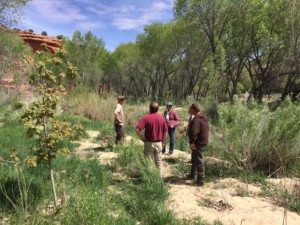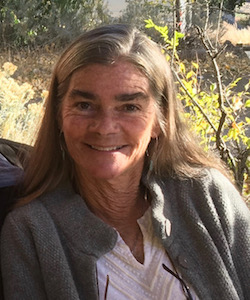By Sue Fearon for EDRBlog.org

Earlier this year, Stan, a conversation partner, asked me “Why are you still here? That’s what I want to know. I’ve been part of half a dozen partnerships, most of them don’t make it past the first meeting, but this one is still getting things done.” Stan referred to the Escalante River Watershed Partnership (ERWP) and I knew what he meant. It was a good question and, to my mind, there are three key reasons why we’re still at it: facilitation, framework, and funding. Remove any one of these elements and ERWP would not be the accomplished, productive partnership it is today.
The Escalante River is one of the last largely free-flowing, small rivers in the American Southwest. Its watershed covers about 1.3 million acres in south-central Utah, within central Garfield and northeastern Kane Counties. In June of 2009, a workshop was held in Boulder, UT to discuss threats to the watershed, opportunities to improve current conditions and to gauge the interest in combining expertise, funding, and resources to achieve large scale restoration. Both fear and hope propelled me to attend that first meeting.
Facilitation
The June 2009 meeting was open to the public. The diverse group of landowners, representatives of NGOs, federal and state agencies, business owners, scientists and stakeholders barely fit around the table. Yet, the first workshop was facilitated quite masterfully by Cherie Shanteau-Wheeler (who was then with the US Institute for Conflict Resolution). Concerns were acknowledged, historical perspectives were valued, mandates were teased out, and tangents didn’t derail. Comprehensive, watershed wide riparian restoration looked hopeful while territorial boundaries began to dissolve.
Get notified when new articles are posted to the EDR blog – sign up for our email list »
From my past experience, I had attended many meetings in southern Utah on various topics where inviting the public seemed like a formality or part of the checklist. After walking out of those meetings, I knew nothing had changed. However, at this particular meeting, everyone had equal standing to voice their opinions and be heard. Ms. Shanteau-Wheeler clearly valued and understood what each participant had to say, provided feedback, asked additional questions and, as the thoughts accumulated, she synthesized the main themes. This respectful, active listening was contagious. Another crucial part to this meeting was that we each left with tasks and next steps to keep this partnership ball rolling. Finally, voicing a concern came with an obligation to be part of a solution. Ultimately, this diverse group was empowered to work together defined by a common mission: restore and maintain the natural ecological conditions of the Escalante River and its watershed, and involve local communities in promoting and implementing sustainable land and water use practices.
Framework
At this first workshop, the greatest threat to the river was recognized as the invasion and spread of Russian olive (Elaeagnus angustifolia) and tamarisk (Tamarix ramosissima). This reflected my experience over the past 25 years, in which I’d seen Russian olive engulf the Escalante River; bend after bend, sunlight couldn’t reach the ground as thickets of Russian olive grew exponentially.
Some workshop participants were chomping at the bit to start work, while others understood that ERWP needed to expend the organizational energy necessary to function as a collaboration. Developing an action plan was a crucial tool to guide activities and priorities while on the ground work was equally important to others. Because every meeting was facilitated, these two strong forces were skillfully blended. Russian olive removal didn’t have to wait for the partnership framework. We had enough interest and support to start these projects concurrently. While part of ERWP spent the early years doing some heavy lifting in terms of developing the framework, others participated in mapping the extent of invasive species, contacting landowners, working with public land managers and raising funds to implement highly visible Russian olive removal projects.
By the end of 2009, ERWP had developed an Action Plan which listed visions and goals, including partnership function and structure, education, outreach, funding and control of woody invasives. By the next year an Action Plan Committee formed to develop a more comprehensive framework to guide the actions of the partnership. Working committees were formed, and soon a Woody Invasive Control Plan, a restoration guide, cutting guides, education and funding plans were developed. All of these living documents have evolved within the partnership to this day. ERWP currently has 6 working committees: Woody Invasive Restoration & Control; Coordinating; Science and Conservation Targets; Education and Outreach; and Fundraising. We’re also actively forming a new subcommittee, Monitoring and Maintenance, as this project transitions from primary treatment to the monitoring and maintenance phase.
Funding
The third piece of the ERWP’s success is consistent funding. Developing a framework for a partnership, and planning and implementing restoration projects, takes paid staff. Most of ERWP’s partners focus on areas and issues broader than the watershed. As the private lands project lead focused solely on the Escalante watershed I am able to lay a foundation with a landowner then gather support from ERWP partners, Natural Resources Conservation Service and/or the US Fish and Wildlife Service, to create a technical and financial partnership around a specific project. While ERWP has always had full participation from public land managers and volunteers, the work load requires a core group who are dedicated to implementing the woody invasive control plan, assist with the geo database, facilitate meetings, write grants, meet landowners, plan community events, and pull all of the partnership resources together to achieve our mission.
There are many more elements that go into a robust partnership, but the crucial pieces for the Escalante River Watershed Partnership are facilitation, framework and funding. If any one of these had been unavailable, I’m not sure ERWP would have survived. At the very least, it would have slowed to a crawl.
 Sue Fearon works for Grand Staircase Escalante Partners developing restoration projects as Private Lands Program Coordinator for Escalante River Watershed Partnership (ERWP). Since 1997, Sue has also worked for the Canyonlands Conservation District, which employs a voluntary approach to assist private property owners in the conservation of soil, water and other natural resources. She is inspired by the intersection of agriculture and wildlands.
Sue Fearon works for Grand Staircase Escalante Partners developing restoration projects as Private Lands Program Coordinator for Escalante River Watershed Partnership (ERWP). Since 1997, Sue has also worked for the Canyonlands Conservation District, which employs a voluntary approach to assist private property owners in the conservation of soil, water and other natural resources. She is inspired by the intersection of agriculture and wildlands.
